OWL takes flight - A detailed look at travel in 2020
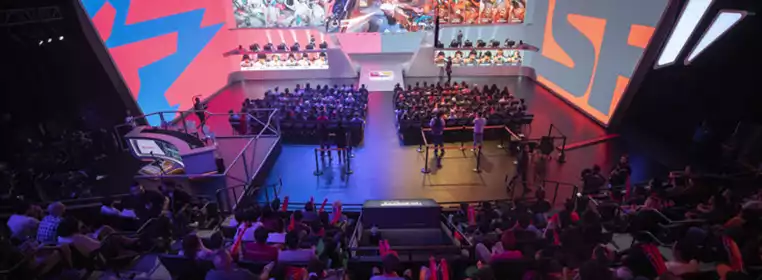
Upon the initial 2020 schedule release, I worked with Eric Doerr on an instant analysis of the travel implications. As we approach the new season, let’s make a pre-flight check on the 2020 Overwatch League and go deeper to identify further advantages and injustices of the season schedule.
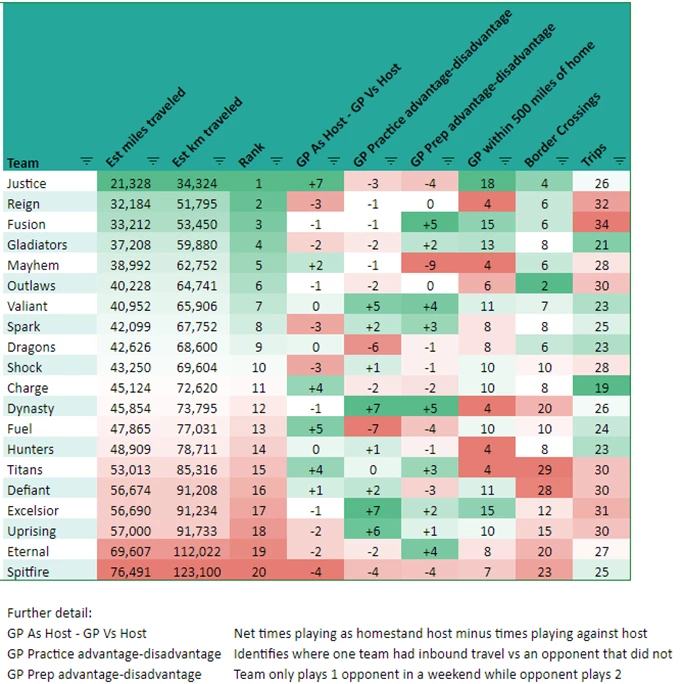
 Click to enlarge
Click to enlargeThe calculations were done under the basic assumption that teams will base in their franchise city and fly back to their home base after each homestand with the exception of two scenarios:
-
If traveling from one homestand directly to the next weekend’s homestand saves 3,000 miles, then the team is assumed to fly directly to the next site. Here’s a practical example: Boston has games on consecutive weekends in London and Paris, so this rule suggests they spend the entire week in Europe rather than flying home. Generally, this also makes financial sense as long distance flights will cost more than the additional hotel nights.
-
A bye week in the middle of an Asia-NA trip will not trigger a return to base. Teams like the Uprising have already commented they will enjoy an entire month on their Asia tour, thus reducing initial travel estimates.
Keep in mind that the above calculations are likely to be low-balled, as media and sponsorship obligations will require additional flights. For example, some teams will have to fly out to the first week of homestands in New York and Dallas, despite not having a match that weekend as the league requires them to do media content for the season. Furthermore, it assumes that teams will shell out for direct flights over connecting flights and doesn’t account for players flying for all star activity, season playoffs, or home during extended breaks and before and after the season.
That being said, let it be screamed from the rooftops:
Strength of schedule is no longer just which opponent you play, but under which conditions the game is played.
Last year, the vast majority of regular season games were played under the same conditions. Teams practiced in consistent environments, competed in front of ~500 fans, and lived within an Uber ride of all of this, so the Strength of Schedule was largely determined by whether your team played in the Atlantic or Pacific division. In 2020, homestand travel will pose new questions on what makes a schedule tough. How will teams perform in front of thousands of enemy fans? How much will travel requirements impact practice time? How will the quality of practice environments differ?
Stepping back, let’s dive into the headline table, starting specifically at estimated miles travelled.
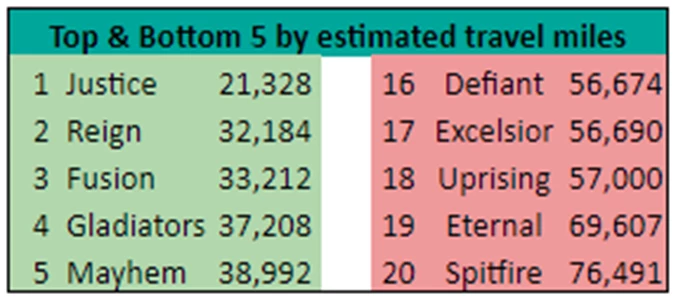
 Click to enlarge
Click to enlargeTraveling is new to the Overwatch League, though its traditional sport inspirations have been operating for decades. ESPN’s @FionnOnFire offered some comparables, citing the NBA’s Lakers and NFL’s Raiders as their league’s top travelling teams at 40,000 and 30,000 miles respectively. These figures would be at the favorable end of the Overwatch League table, though the NBA and NFL means of travel is not easily comparable. While LeBron’s Lakers travel on-demand in cozy private jets, most OWL teams will wind up flying commercially in economy seats below traditional sports standards. Anticipating issues with commercial flights, the league requires teams to arrive on the Thursday before their weekend games, though it’s hard to imagine everything goes perfectly with 200 twenty-somethings traveling millions of combined miles. All of this was to be expected and appears reasonable in the economic scope of the league if both teams and the league itself have built enough redundancy into their systems to catch the occasional unexpected complication.
A more apt comparison, perhaps, would be to other esports. At Dallas Fuel owner Mike Rufail’s inquiry, we ran back-of-the-envelope estimates for CS:GO stalwarts Team Liquid and Astralis. These teams travelled at least 90,000 miles and 75,000 miles respectively, more than the regular season estimates above, though there are caveats. First, CS:GO teams can voluntarily choose to attend or skip circuit events, and second, those numbers were spread out over an entire year, while the OWL estimates cover a low-ball estimate of the 6 month regular season. In the end, the Overwatch League Homestand model is certainly pushing the envelope working on the road.
The Host with the Most
With the switch to the homestand model, most franchises opted for the minimum of 2 events, though a few stood up to organize more. Using data from the NFL, we can estimate the advantage gained by hosting, and also lost by drawing the short straw to play against the host.
Dallas, Guangzhou, and Washington all host 10 of their 28 games played, and in the luck of the draw, teams range from 0 games played versus a homestand host (Titans) to 8 games played vs homestand hosts (Spitfire, Gladiators, Eternal). Applying an NFL-inspired 57% to home field advantage, we can generate an estimated advantage for even strength teams.
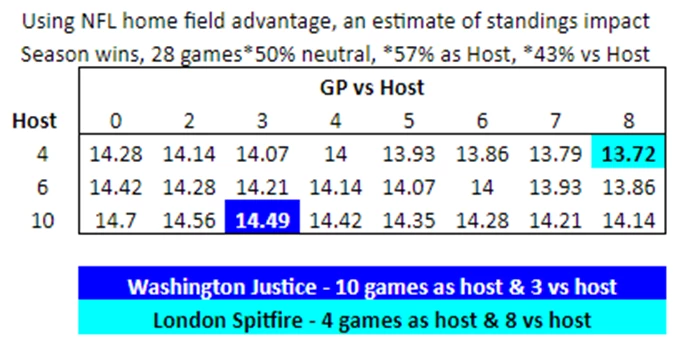
 Click to enlarge
Click to enlargeBefore you underestimate the value of the above, note that it took 13 wins for the Chengdu Hunters to make the play-ins last year. On neutral terms, Washington is effectively getting an extra game and a half to get enough wins to make playoffs that London does not. Who said the Justice’s system was ever fair?
Practice? You talkin’ bout Practice?
One of my biggest concerns this year is how inconsistent or insufficient practice conditions will affect the level of play. In looking at the schedule, we considered multiple factors that would impair quantity or quality of match preparation.
The theoretical typical weekly schedule would be to fly back from the prior homestand event on Monday, have full practice Tuesday and Wednesday before flying to the next homestand on Thursday, though if a team isn’t traveling on Monday or Thursday they gain extra days of practice ahead of the following match. In the headline table, this is quantified under “GP Practice advantage-disadvantage”. The Dynasty and Excelsior benefit the most with a net +7 games played where their schedule predicts extra practice time compared to their opponents for that week. At the opposite end, the Dragons (-6) and Fuel (-7) may hope to rely on improvisation over set plays while often playing at a practice time disadvantage.
A second angle to consider is how advantageous is it to only have to prepare for one team? We looked at how often a team has only one game on the schedule yet their opponent has two (an advantage) or vice versa (disadvantage). By far, the Mayhem suffer the most under this metric, they have 3 weekends where they can specifically prep for their only opponent yet 12 other weekends where their opponent is focused only on beating Florida, a net -9. On the other hand, the Fusion and Dynasty have a net +5 weekends where they can prepare opponent-specific strategies.
How much additional practice will matter compared to the other circumstances of the travel schedule remains to be seen and is likely to be different from team to team. It’s likely that we’ll only get to hear of a full account of all the aforementioned factors after the season concludes. From all this theoretical, let’s shift to a practical example of how the homestand model could #ShockTheWorld.
Early Tremors for the Shock?
The San Francisco Shock are riding a 16 map win streak after crushing last season’s playoffs and are locked in to first place on just about every preseason power ranking, but they could give us the first taste of how important travel will be.
The Shock open the season in Dallas and then hit the road for Asia. In 2019, the Shock would be considered heavy favorites to go at least 5-1 against the Fuel, Charge, Dragons, Hunters, Spark, and Dynasty, but 2020 brings new challenges.
In all of their first six games, the Shock either play against the homestand hosts or against a team within a two hour flight of their franchise city. Thousands of fans will actively cheer against the World Champions as they play the Fuel in Dallas, three Chinese teams in China, then a heavily Korean Spark squad and the Dynasty in Seoul. Given these disadvantages, add a cultural adjustment to the food and timezones, and perhaps a 3-3 start doesn’t seem so bad in hindsight after we’ve gained more insight into the impact of travel.
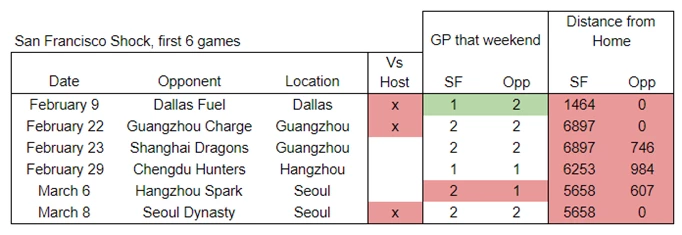
 Click to enlarge
Click to enlargeNow consider the implications for the new midseason tournament. Held during the All-star break, four teams compete for a $500,000 top prize with invites based on the standings for each team’s first 9 games played. Due to their tough early stretch, it is quite feasible that the indomitable San Francisco Shock miss the midseason tournament while teams with quietly softer early schedules seize these top 4 midseason spots. Are fans ready for such a scenario?
Turbulence in the Flight Plan
Despite an off-season arms race during which most teams appear to have improved, travel and schedule issues are ready to lay a heavy hand on this season’s results. Which teams & players will this impact the most? It follows that the players most affected will be the heavy grinders that require long practice hours to hold their level. Time needed to travel and the constantly changing surroundings will diminish their advantages of extreme stamina and extended practice time, relative to players more reliant on natural talent and improvisation. I go as far as to predict that we will think of some players wildly differently, with stars dropping off a cliff and slackers making it big. The lazy man at OWL-level in 2019 might be 2020’s king.
On the franchise side, 2019 played true to form based on preseason power rankings, but it’s reasonable to expect more volatility due to all the factors that may influence team performance. With that, team win-loss records may converge, away from the extremes like 2019’s Titans & Mayhem towards a tighter playoff race where the final matches come down to a photo finish in more places than just the play-ins.
Overall, the new travel format will significantly impact which teams and players succeed, come back tomorrow for an in-depth look at unique winners and losers. Fans and franchises alike are advised to buckle up, we are about to take off.
Image courtesy of Robert Paul for Blizzard Entertainment
